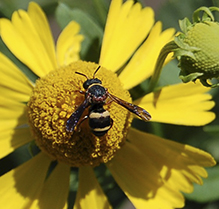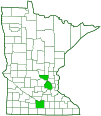two-banded cellophane-cuckoo bee
(Epeolus bifasciatus)
Conservation • Description • Habitat • Ecology • Distribution • Taxonomy
Conservation Status |
|
|||||||
| IUCN Red List | not listed |
|||||||
| NatureServe | NNR - Unranked SNR - Unranked |
|||||||
| Minnesota | not listed |
|||||||
Description |
||
Two-banded cellophane-cuckoo bee is a moderate-sized, kleptoparasitic, cuckoo bee. It occurs in the United States east of the Rocky Mountains, in southern Quebec and Ontario Canada, and in Mexico. It is a nest parasite of a cellophane bee, probably broad-footed cellophane bee. Adults are found from June to September in meadows and at forest edges. Adults are ¼″ to ⅜″ (7 to 9 mm) in length and wasp-like in appearance. The body is robust and mostly black with reddish and reddish-orange areas and yellow markings. The head and face are black. The cheeks are very narrow. On the female there is a patch of silvery or yellow hairs circling the outer half of the base of each antenna. On females the antennae have 13 segments, including a long basal segment (scape), a short second segment (pedicel), and a whip-like section (flagellum) with 11 segments (flagellomeres). On each antenna, the scape, pedicel, and first flagellomere are reddish-orange, the rest of the antenna is black. On males the antennae have just 12 segments. The tongue is long and slender. On the male there is a rounded, bump-like protrusion near the upper front margin of each compound eye. It has a fine-grained (granulose) texture. The thorax is black. The front plate (pronotum) is short, collar-like, reddish-orange, and covered with short, bright yellow hairs that form an uninterrupted band. There is a rounded lobe on each side that does not reach the plate covering the wing base (tegula). The large second plate (scutum), covering most of the thorax, is entirely black with no white lines or other markings. The third plate (scutellum) is crescent-shaped, reddish, and has a spine at each side. The rear plate (metanotum) is covered with short, pale yellow hairs forming a band that is narrowly interrupted in the middle. On the side of the thorax, the large front plate (mesopleuron) is shiny and has sparse small punctures on the lower half, and numerous large punctures on the upper half. The abdomen is black and short. The first segment has a broad band of yellow hairs that narrow toward the middle and is narrowly interrupted in the middle. Below this there is usually a thin band of yellow hairs. The second segment has a narrower, uninterrupted band of yellow hairs at the rear margin. The wings are dark. The forewing has three submarginal cells. The lobe at the base of the hindwing (jugal lobe) is shorter than the submedian cell. The tegulae are reddish-orange. The legs are mostly reddish-orange. On the hind leg the third segment (femur) is reddish-orange on the upper side, black on the underside. |
||
Size |
||
¼″ to ⅜″ (7 to 9 mm) |
||
Similar Species |
||
Habitat |
||
Meadows, forest edges |
||
Ecology |
||
Season |
||
June to September |
||
Behavior |
||
|
||
Life Cycle |
||
The female lays an egg in the nest of a cellophane bee, probably broad-footed cellophane bee (Colletes latitarsis). |
||
Larva Food |
||
When the egg hatches, the larva eats the egg of the host bee, then eats the pollen provisioned for that egg. |
||
Adult Food |
||
Flower nectar |
||
Distribution |
||||
|
Sources |
|||
| 12/15/2022 | ||||
Occurrence |
||||
Uncommon |
||||
Taxonomy |
|||
Order |
Hymenoptera (Ants, Bees, Wasps, and Sawflies) | ||
Suborder |
Apocrita (Narrow-waisted Wasps, Ants, and Bees) | ||
Infraorder |
Aculeata (Ants, Bees, and Stinging Wasps) | ||
Superfamily |
Apoidea (Bees and Apoid Wasps) | ||
| Epifamily | Anthophila (bees) | ||
Family |
Apidae (honey bees, bumble bees, and allies) | ||
Subfamily |
Nomadinae (nomad and related cuckoo bees) | ||
Tribe |
Epeolini | ||
| Subtribe | Epeolina | ||
Genus |
Epeolus (cellophane-cuckoo bees) | ||
Synonyms |
|||
|
|||
Common Names |
|||
two-banded cellophane-cuckoo bee two-spotted cuckoo nomad bee |
|||
Glossary
Femur
On insects and arachnids, the third, largest, most robust segment of the leg, coming immediately before the tibia. On humans, the thigh bone.
Flagellomere
A segment of the whip-like third section of an insect antenna (flagellum).
Jugal lobe
In Hymenoptera: The rear lobe at the base of the hindwing.
Pedicel
On plants: the stalk of a single flower in a cluster of flowers. On insects: the second segment of the antennae. On Hymenoptera and Araneae: the narrow stalk connecting the thorax to the abdomen: the preferred term is petiole.
Scape
In plants: An erect, leafless stalk growing from the rootstock and supporting a flower or a flower cluster. In insects: The basal segment of the antenna.
Scutellum
The exoskeletal plate covering the rearward (posterior) part of the middle segment of the thorax in some insects. In Coleoptera, Hemiptera, and Homoptera, the dorsal, often triangular plate behind the pronotum and between the bases of the front wings. In Diptera, the exoskeletal plate between the abdomen and the thorax.
Scutum
The forward (anterior) portion of the middle segment of the thorax (mesonotum) in insects and some arachnids.
Tegula
A small, hardened, plate, scale, or flap-like structure that overlaps the base of the forewing of insects in the orders Lepidoptera, Hymenoptera, Diptera, and Homoptera. Plural: tegulae.
Visitor Photos |
|||||
Share your photo of this insect. |
|||||
| This button not working for you? Simply email us at info@MinnesotaSeasons.com. Attach one or more photos and, if you like, a caption. |
|||||
Bob Payton |
|||||
 |
|||||
MinnesotaSeasons.com Photos |
|||||
|
|||||

Visitor Videos |
|||
Share your video of this insect. |
|||
| This button not working for you? Simply email us at info@MinnesotaSeasons.com. Attach a video, a YouTube link, or a cloud storage link. |
|||
Other Videos |
|||

Created: 12/15/2022
Last Updated:




